Monitoring Population Evolution in China Using Time-Series DMSP/OLS Nightlight Imagery
Abstract
:1. Introduction
2. Study Area and Datasets
2.1. Study Area
2.2. Data Source
3. Methodology
3.1. Inter-Calibration
3.2. Geometric Correction
3.3. Incompatibility and Discontinuity Correction
3.4. Adjustment Based on the Vegetation Distribution Information
3.5. Population Spatialization
3.6. Estimation of Corrected NLT Products
3.7. Population-Weighted Centroid Model
4. Results and Analysis
4.1. Evaluation of the Corrected NLT Products
4.2. Evaluation of the Spatialized Population
4.3. Spatio-Temporal Differences of Estimated Population Distribution and Its Dynamics in Chinese Four Economic Regions
4.4. Spatio-Temporal Differences of the Estimated Population Distribution and Its Dynamics among Nine-Level Population Density Types
5. Discussion
6. Conclusions
Acknowledgments
Author Contributions
Conflicts of Interest
References
- Zeng, C.; Zhou, Y.; Wang, S.; Yan, F.; Zhao, Q. Population spatialization in China based on night-time imagery and land use data. Int. J. Remote Sens. 2011, 24, 9599–9620. [Google Scholar] [CrossRef]
- Obienusi, E.A.; Ekezie, M.; Onwuka, S.U. Investigating the place of population increase and level of income earning in food security a study of yam supply in Awka urban, Anambra state of Nigeria. J. Nat. Sci. Res. 2014, 11, 11–21. [Google Scholar]
- Hutchinson, J.; Hutchinson, J. Population and food supply. BMJ-Br. Med. J. 1969, 3893, 320. [Google Scholar]
- Wang, C.; Liu, Y.; Kong, X.; Li, J. Spatiotemporal decoupling between population and construction land in urban and rural Hubei province. Sustainability 2017, 7, 1258. [Google Scholar] [CrossRef]
- Zhang, Y. Research on the effects of changes in the age structure of China’s population to energy consumption: Based on the provincial dynamic panel data by GMM. China Popul. Resour. Environ. 2015, 11, 69–74. [Google Scholar]
- Yigzaw, W.; Hossain, F. Water sustainability of large cities in the United States from the perspectives of population increase, anthropogenic activities, and climate change. Earths Future 2016, 12, 603–617. [Google Scholar] [CrossRef]
- Atasoylu, G.; Evci, E.D.; Kaya, E.; Ergin, F.; Tikir, D.; Beser, E. The household garbage in the western coast region of Turkey and its relationship with the socio-economic characteristics. J. Environ. Biol. 2007, 28, 225–229. [Google Scholar] [PubMed]
- János, N. Climate change, agricultural land use and food safety. Econ. Aic 2014, 7, 149–157. [Google Scholar]
- Li, L.; Lei, Y.; Pan, D.; Si, C. Research on sustainable development of resource-based cities based on the DEA approach: A case study of Jiaozuo, China. Math. Probl. Eng. 2016, 3, 1–10. [Google Scholar] [CrossRef]
- Miao, C.L.; Sun, L.Y.; Yang, L. The studies of ecological environmental quality assessment in Anhui Province based on ecological footprint. Ecol. Indic. 2016, 60, 879–883. [Google Scholar] [CrossRef]
- Pan, R.; Liu, Y.; Sun, H. The coupling analysis of population urbanization and economic development: Take the case of counties (Cities, Areas) of Henan Province. Geomat. Spat. Inf. Technol. 2016, 3, 85–89. [Google Scholar]
- Ma, T.; Zhou, Y.; Zhou, C.; Haynie, S.; Pei, T.; Xu, T. Night-time light derived estimation of spatio-temporal characteristics of urbanization dynamics using DMSP/OLS satellite data. Remote Sens. Environ. 2015, 158, 453–464. [Google Scholar] [CrossRef]
- Bennett, M.M.; Smith, L.C. Advances in using multitemporal night-time lights satellite imagery to detect, estimate, and monitor socioeconomic dynamics. Remote Sens. Environ. 2017, 192, 176–197. [Google Scholar] [CrossRef]
- Proville, J.; Zavalaaraiza, D.; Wagner, G. Night-time lights: A global, long term look at links to socio-economic trends. PLoS ONE 2017, 3, e0174610. [Google Scholar] [CrossRef] [PubMed]
- Gao, Q.; Ka-Simu, A. Modeling the population spatial distribution of Tianshan north-slope urban agglomeration based on DMSP/OLS night lighting data. Northwest Popul. J. 2017, 3, 113–120. [Google Scholar]
- Letu, H.; Hara, M.; Tana, G.; Bao, Y.; Nishio, F. Generating the nighttime light of the human settlements by identifying periodic components from DMSP/OLS satellite imagery. Environ. Sci. Technol. 2015, 17, 10503–10509. [Google Scholar] [CrossRef] [PubMed]
- Amaral, S.; Câmara, G.; Monteiro, A.M.V.; Quintanilha, J.A.; Elvidge, C.D. Estimating population and energy consumption in Brazilian Amazonia using DMSP night-time satellite data. Comput. Environ. Urban Syst. 2005, 2, 179–195. [Google Scholar] [CrossRef]
- Xie, Y.; Weng, Q. World energy consumption pattern as revealed by DMSP-OLS nighttime light imagery. Gisci. Remote Sens. 2016, 2, 265–282. [Google Scholar] [CrossRef]
- Wang, Y.; Li, G. Mapping urban CO2 emissions using DMSP/OLS’ city lights satellite data in China. Environ. Plan. A 2017, 2, 248–251. [Google Scholar] [CrossRef]
- Shi, K.; Chen, Y.; Yu, B.; Xu, T.; Chen, Z.; Liu, R.; Li, L.; Wu, J. Modeling spatiotemporal CO2 (carbon dioxide) emission dynamics in China from DMSP-OLS nighttime stable light data using panel data analysis. Appl. Energy 2016, 168, 523–533. [Google Scholar] [CrossRef]
- Guo, X.; Yan, Q.; Tan, X.; Liu, S. Spatial distribution of carbon emissions based on DMSP/OLS nighttime light data and NDVI in Jiangsu province. World Reg. Stud. 2016, 4, 102–110. [Google Scholar]
- Letu, H.; Takashi, Y.N.; Fumihiko, N. Regional-scale estimation of electric power and power plant CO2 emissions using defense meteorological satellite program operational linescan system nighttime satellite data. Environ. Sci. Technol. Lett. 2014, 1, 259–265. [Google Scholar] [CrossRef]
- Jiang, W.; He, G.; Long, T.; Wang, C.; Ni, Y.; Ma, R. Assessing Light Pollution in China Based on Nighttime Light Imagery. Remote Sens. 2017, 2, 135. [Google Scholar] [CrossRef]
- Guo, S.; Gong, J.; Yin, J. Study on grid refinement for population distribution based on DMSP/OLS. J. Seismol. Res. 2016, 2, 321–326. [Google Scholar]
- Song, G.; Yu, M.; Liu, S.; Zhang, S. A dynamic model for population mapping: A methodology integrating a Monte Carlo simulation with vegetation-adjusted night-time light images. Int. J. Remote Sens. 2015, 15, 4055–4068. [Google Scholar] [CrossRef]
- Huang, J.; Yan, Q.; Liu, Y. Modeling the population density of Jiangsu Province based on DMSP/OLS satellite imagery and land use data. Resour. Environ. Yangtze Basin 2015, 5, 735–741. [Google Scholar]
- Yang, X.; Yue, W.; Gao, D. Spatial improvement of human population distribution based on multi-sensor remote-sensing data: An input for exposure assessment. Int. J. Remote Sens. 2013, 15, 5569–5583. [Google Scholar] [CrossRef]
- Shao, Z.; Liu, C. The integrated use of DMSP-OLS Nighttime Light and MODIS data for monitoring large-scale impervious surface dynamics: A case study in the Yangtze River Delta. Remote Sens. 2014, 6, 9359–9378. [Google Scholar] [CrossRef]
- Bai, Z.; Wang, J. Generation of high resolution population distribution map in 2000 and 2010: A case study in the Loess Plateau, China. In Proceedings of the International Conference on Geoinformatics, Wuhan, China, 19–21 June 2015; pp. 1–6. [Google Scholar]
- Lo, C.P. Modeling the population of china using DMSP operational linescan system nighttime data. Photogramm. Eng. Remote Sens. 2001, 9, 1037–1047. [Google Scholar]
- Geer, S.D. A map of the distribution of population in Sweden: Method of preparation and general results. Geogr. Rev. 1922, 1, 72–83. [Google Scholar] [CrossRef]
- Zhuo, L.; Ichinose, T.; Zheng, J.; Chen, J.; Shi, P.; Li, X. Modelling the population density of China at the pixel level based on DMSP/OLS non-radiance-calibrated night-time light images. Int. J. Remote Sens. 2009, 4, 1003–1018. [Google Scholar] [CrossRef]
- Illeris, S. Counter-urbanization revisited: The new map of population distribution in central and north-western Europe. Nor. Geogr. Tidsskr. 1990, 1, 39–52. [Google Scholar] [CrossRef] [PubMed]
- Zhao, N.; Zhou, Y.; Samson, E.L. Correcting incompatible DN values and geometric errors in nighttime lights time-series images. IEEE Trans. Geosci. Remote Sens. 2015, 4, 2039–2049. [Google Scholar] [CrossRef]
- Zhao, N.; Ghosh, T.; Samson, E.L. Mapping spatio-temporal changes of Chinese electric power consumption using night-time imagery. Int. J. Remote Sens. 2012, 20, 6304–6320. [Google Scholar] [CrossRef]
- Liu, Z.; He, C.; Zhang, Q.; Huang, Q.; Yang, Y. Extracting the dynamics of urban expansion in China using DMSP-OLS nighttime light data from 1992 to 2008. Landsc. Urban Plan. 2012, 1, 62–72. [Google Scholar] [CrossRef]
- Cao, Z.; Wu, Z.; Kuang, Y.; Huang, N. Correction of DMSP/OLS night-time light images and its application in China. J. Geo-Inf. Sci. 2015, 1, 1010–1016. [Google Scholar]
- Letu, H.; Hara, M.; Yagi, H.; Tana, G. Estimating the energy consumption with nighttime city light from the DMSP/OLS imagery. In Proceedings of the Urban Remote Sensing Event, Shanghai, China, 20–22 May 2009; pp. 1–7. [Google Scholar]
- Letu, H.; Hara, M.; Tana, G.; Nishio, F. A saturated light correction method for DMSP/OLS nighttime satellite imagery. IEEE Trans. Geosci. Remote Sens. 2012, 2, 389–396. [Google Scholar] [CrossRef]
- Raupach, M.; Rayner, P.; Paget, M. Regional variations in spatial structure of nightlights, population density and fossil-fuel CO2 emissions. Energy Policy 2010, 9, 4756–4764. [Google Scholar] [CrossRef]
- Wu, J.; He, S.; Peng, J.; Li, W.; Zhong, X. Intercalibration of DMSP-OLS night-time light data by the invariant region method. Int. J. Remote Sens. 2013, 20, 7356–7368. [Google Scholar] [CrossRef]
- Hsu, F.C.; Baugh, K.E.; Ghosh, T.; Zhizhin, M.; Elvidge, C.D. DMSP-OLS radiance calibrated nighttime lights time series with intercalibration. Remote Sens. 2015, 2, 1855–1876. [Google Scholar] [CrossRef]
- Zhang, Q.; Schaaf, C.; Seto, K.C. The vegetation adjusted NTL urban index: A new approach to reduce saturation and increase variation in nighttime luminosity. Remote Sens. Environ. 2013, 2, 32–41. [Google Scholar] [CrossRef]
- Zhuo, L.; Zhang, X.; Zheng, J.; Tao, H.; Guo, Y. An EVI-based method to reduce saturation of DMSP/OLS nighttime light data. Acta Geogr. Sin. 2015, 8, 1339–1350. [Google Scholar]
- Cao, L.; Li, P.; Zhang, L. Urban population estimation based on the DMSP/OLS night-time satellite data——A case of Hubei Province. Remote Sens. Inf. 2009, 4, 35–45. [Google Scholar]
- Li, P.; Hong, H. Estimation of urban population in Guangdong Province based on DMSP-OLS lighting data. J. South China Normal Univ. (Nat. Sci. Ed.) 2015, 2, 102–107. [Google Scholar]
- Liang, Y.; Xu, Z. Modeling the spatial distribution of GDP based on night light radiation: A case study in Ganzhou District, Zhangye Municipality. J. Glaciol. Geocryol. 2013, 1, 249–254. [Google Scholar]
- Zhuo, L.; Chen, J.; Shi, P.; Gu, Z.; Fan, Y.; Yi, Z. Modeling population density of china in 1998 based on DMSP/OLS nighttime light image. Acta Geogr. Sin. 2005, 2, 266–276. [Google Scholar]
- Gu, X.; Li, M.; Xu, D.; Zhang, B.; Nie, X.; Li, H.; Wang, S.; Zhang, Z.; Liu, Q.; Li, J. Report on Remote Sensing Monitoring of China Sustainable Development (2016); Social Sciences Academic Press: Beijing, China, 2016. [Google Scholar]
- Hou, X. Research on the balanced development of China’s urbanization and industrialization in eastern, central, western and northeastern regions. Asian Agric. Res. 2011, 3, 124–128. [Google Scholar]
- Shi, L.; Taubenböck, H.; Zhang, Z.; Liu, F.; Wurm, M. Urbanization in China from the end of 1980s until 2010—Spatial dynamics and patterns of growth using EO-data. Int. J. Digit. Earth 2017, 1–17. [Google Scholar] [CrossRef]
- Elvidge, C.D.; Ziskin, D.; Baugh, K.E.; Tuttle, B.T.; Ghosh, T.; Pack, D.W.; Erwin, E.H.; Zhizhin, M. A Fifteen Year Record of Global Natural Gas Flaring Derived from Satellite Data. Energies 2009, 3, 595–622. [Google Scholar] [CrossRef]
- Bo, Z.; Wang, J.; Yang, F. Research progress in spatialization of population data. Prog. Geogr. 2013, 11, 1692–1702. [Google Scholar]
- Wang, S.; Liu, J.; Zhang, Z.; Zhou, Q.; Wang, C. Spatial pattern change of land use in china in recent 10 years. Acta Geogr. Sin. 2002, 5, 523–530. [Google Scholar]
- Ge, M.; Feng, Z. Population distribution of china based on GIS: Classification of population densities and curve of population gravity centers. Acta Geogr. Sin. 2009, 2, 202–210. [Google Scholar]
- Yang, Q.; Li, L.; Wang, Y.; Wang, X.; Lu, Y. Spatial distribution pattern of population and characteristics of its evolution in China during 1935–2010. Geogr. Res. 2016, 8, 1547–1560. [Google Scholar]
- Fan, J.; Liu, J.; Zhang, X.; Cumtb, B. Urbanization Effect on Regional Household Energy Consumption in China. China Popul. Resour. Environ. 2015, 1, 55–60. [Google Scholar]
- Xiao, Y.; Li, Y.; Lei, J. Analysis on China’s Provincial Population Migration and Its Impact on Regional Economic Development since the New Century. Popul. J. 2013, 3, 5–14. [Google Scholar]
- Wang, G. Migration and Regional Development in Central China: Evidence based on Fifth Census and Sixth Census. Econ. Probl. 2017, 5, 123–129. [Google Scholar]
- Gan, J.; Guo, F.; Chen, C.; Liu, J.; Li, Z. The Spatio-temporal Evolution Characteristics of Urbanization Spatial Differentiation in Northeast China. Sci. Geogr. Sin. 2015, 5, 565–574. [Google Scholar]
- Guo, F.; Gu, L.; Chen, C.; Gan, J. Spatial-Temporal Coupling Characteristics of Population Urbanization and Land Urbanization in Northeast China. Econ. Geogr. 2015, 9, 49–56. [Google Scholar]
- Qian, S. Research on population growth of large cities in Central and Western regions. Spec. Zone Econ. 2007, 9, 159–161. [Google Scholar]
- Li, Q.; Lu, L.; Weng, Q.; Xie, Y.; Guo, H. Monitoring urban dynamics in the southeast U.S.A. using time-series DMSP/OLS nightlight imagery. Remote Sens. 2016, 7, 578. [Google Scholar] [CrossRef]
- Ni, Y.; Zhou, X.; Jiang, W. A reducing saturation method for DMSP/OLS nighttime light image combining Landsat data. Remote Sens. Technol. Appl. 2017, 4, 721–727. [Google Scholar]

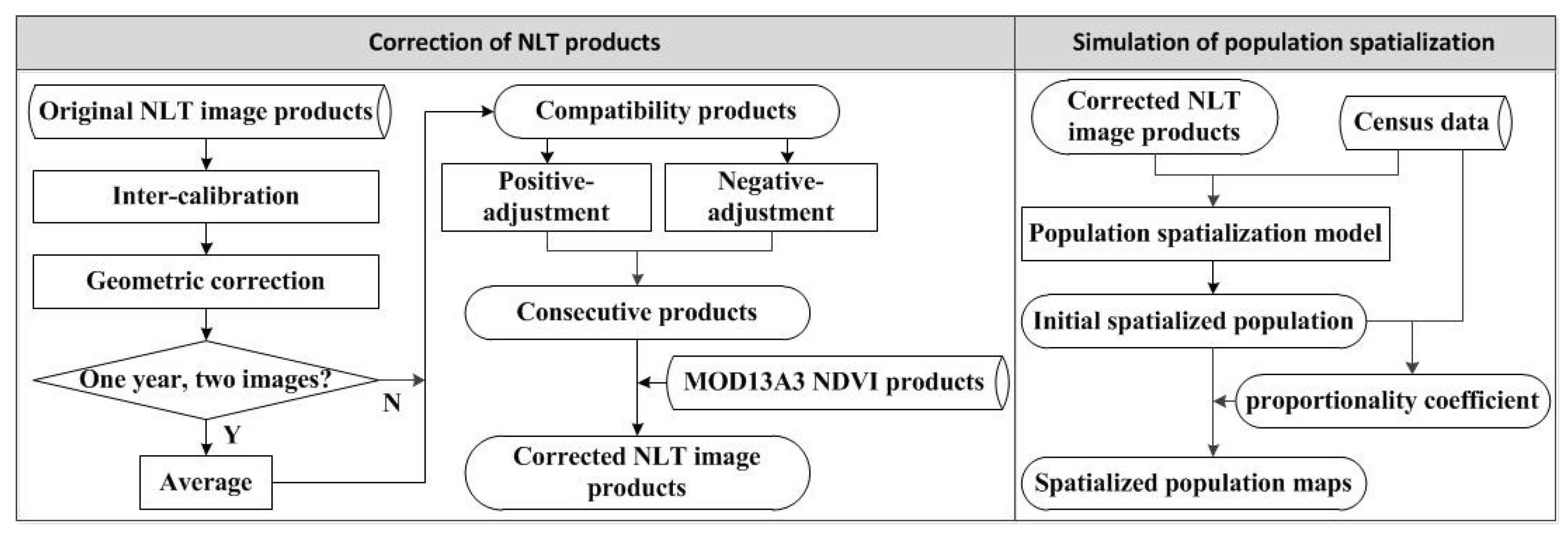
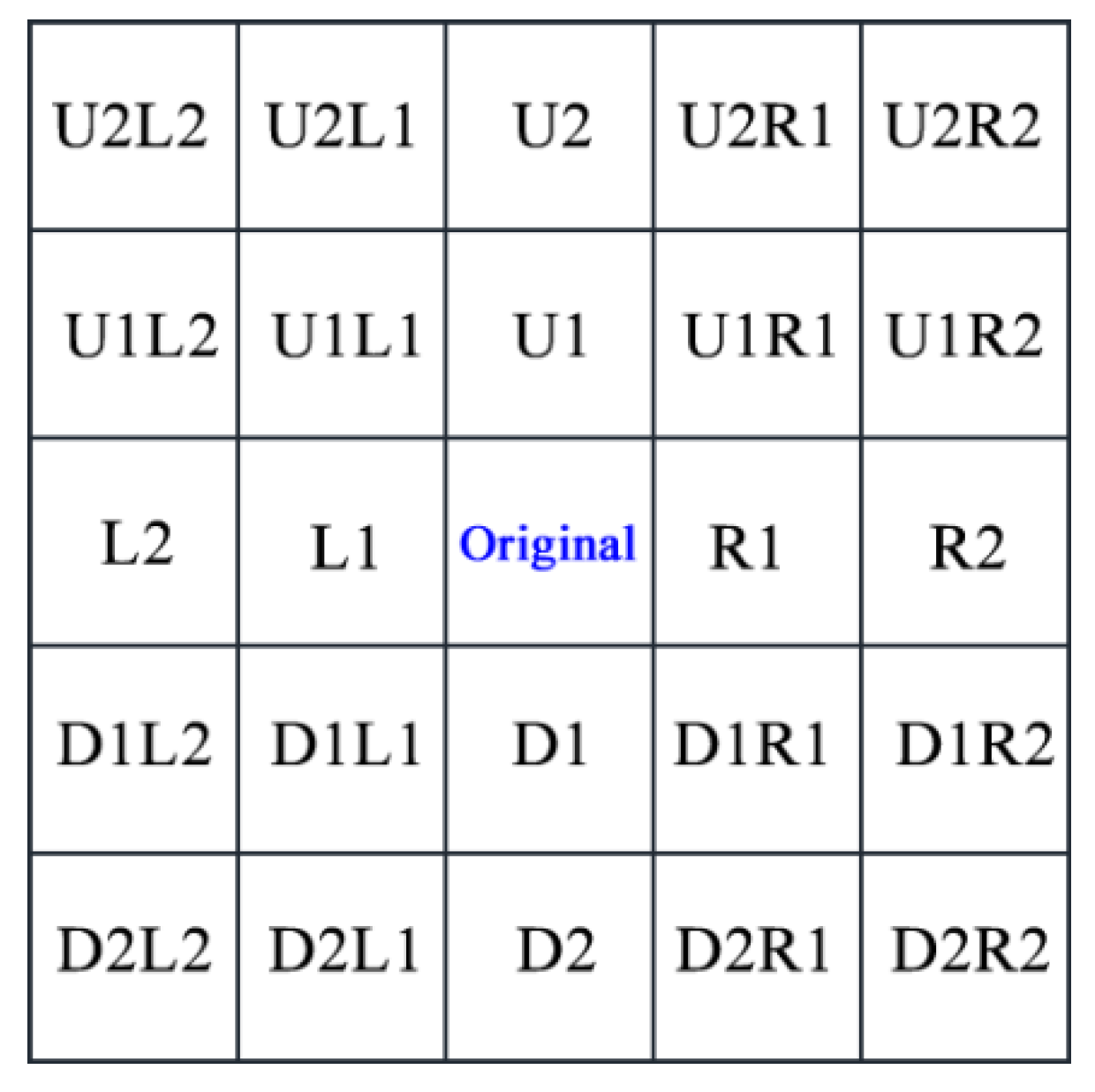


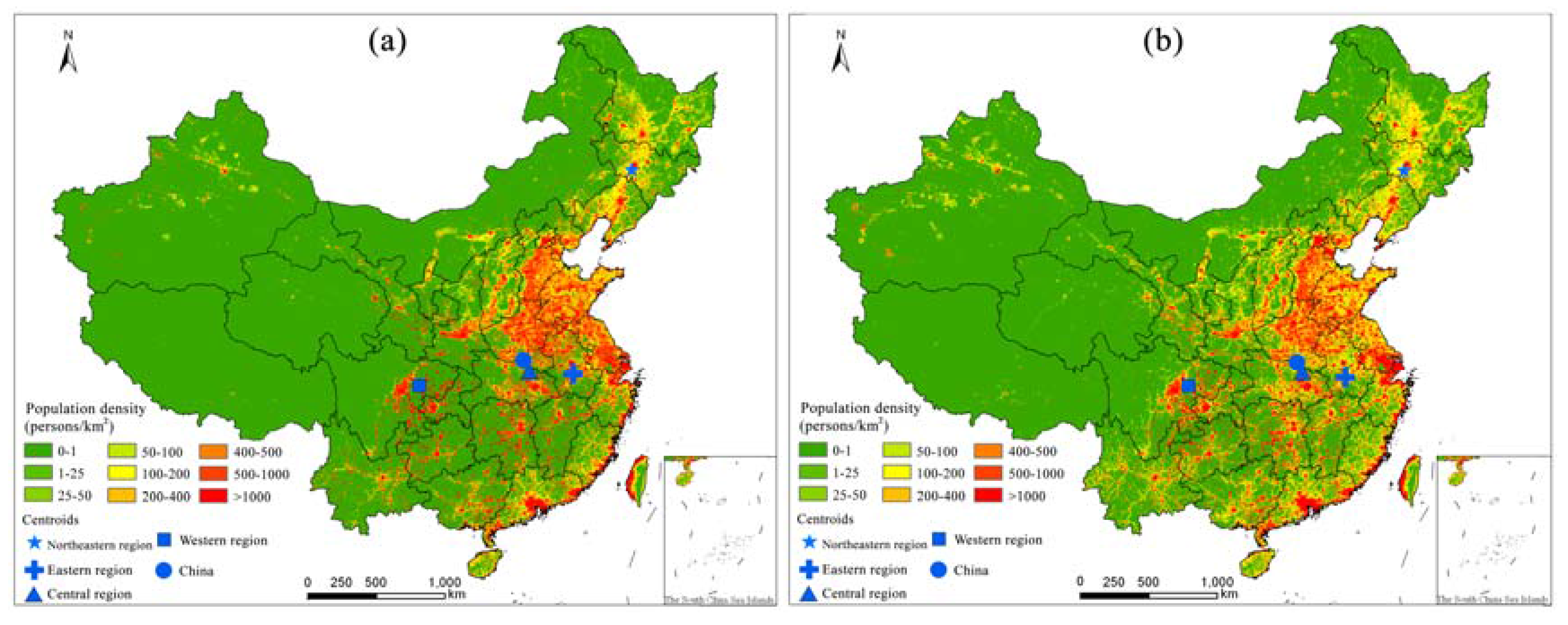

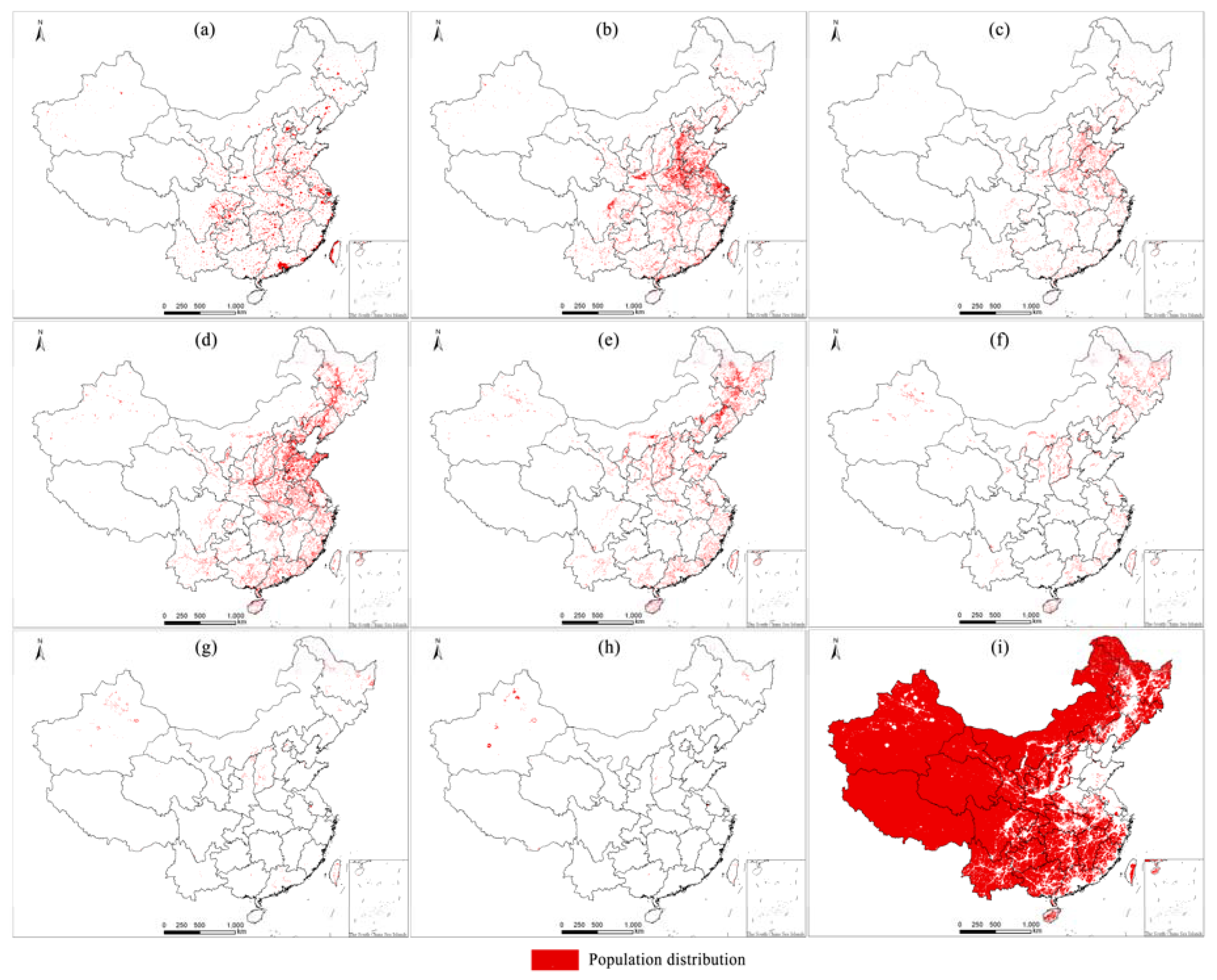
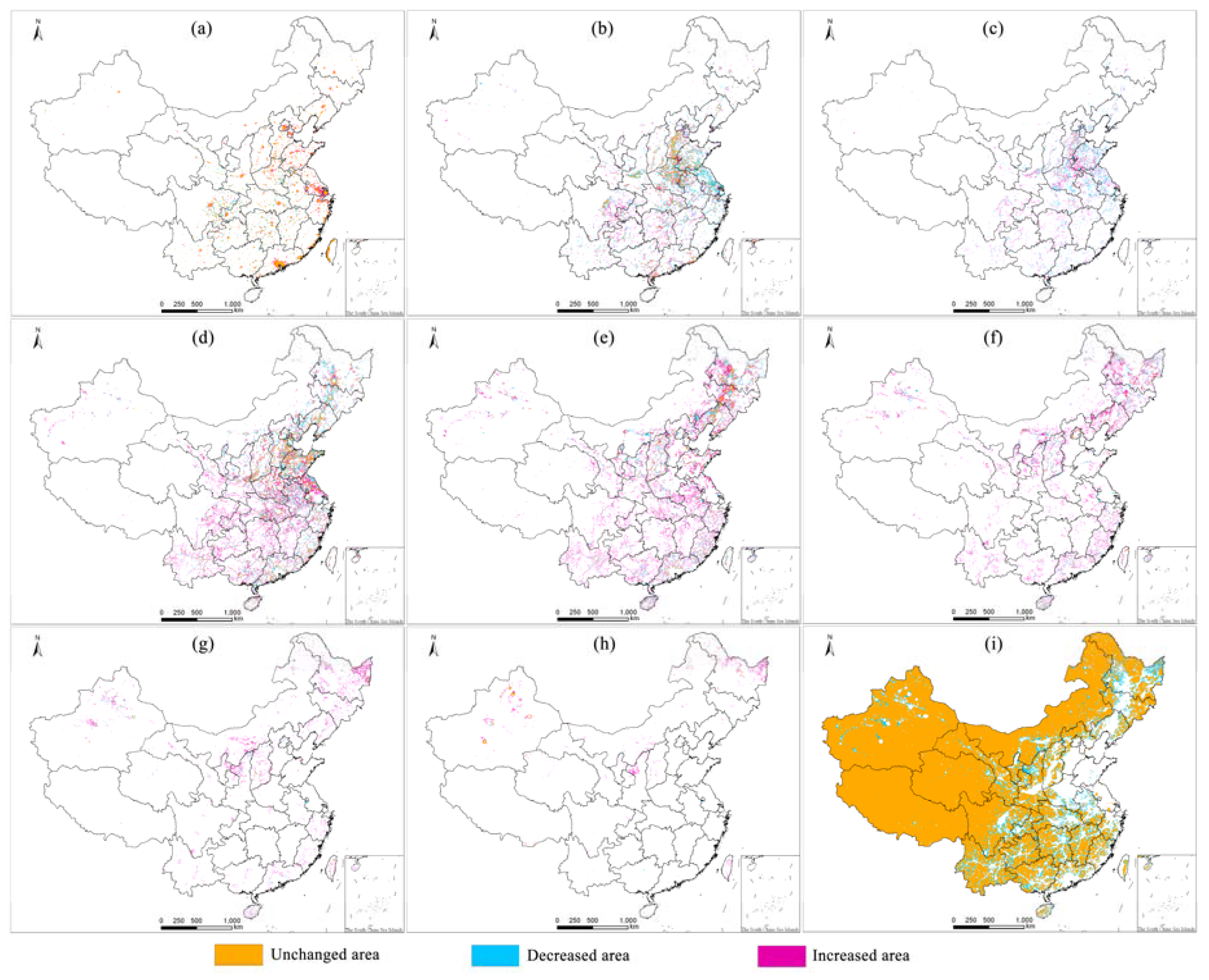
| Satellite | α0 | α1 | α2 | R2 | MSE |
|---|---|---|---|---|---|
| F101992 | 0.9977 | 0.8210 | 0.0020 | 0.9322 | 4.4541 |
| F101993 | −0.3270 | 1.0045 | −0.0005 | 0.9655 | 3.1623 |
| F101994 | 1.0659 | 0.8465 | 0.0013 | 0.9603 | 3.3984 |
| F121994 | 1.5212 | 0.5684 | 0.0058 | 0.9611 | 3.3650 |
| F121995 | 0.8347 | 0.6920 | 0.0036 | 0.9642 | 3.2285 |
| F121996 | 1.3949 | 0.6709 | 0.0045 | 0.9667 | 3.1131 |
| F121997 | 0.8742 | 0.6295 | 0.0050 | 0.9654 | 3.1744 |
| F121998 | 1.0554 | 0.5449 | 0.0055 | 0.9736 | 2.7661 |
| F121999 | 1.5706 | 0.4731 | 0.0063 | 0.9613 | 3.3543 |
| F141997 | 0.1358 | 1.0701 | −0.0011 | 0.9656 | 3.1639 |
| F141998 | 1.0393 | 0.9663 | −0.0005 | 0.9618 | 3.3234 |
| F141999 | 0.4384 | 0.9250 | 0.0004 | 0.9632 | 3.2734 |
| F142000 | 1.2695 | 0.8043 | 0.0018 | 0.9569 | 3.5542 |
| F142001 | 0.7832 | 0.7858 | 0.0023 | 0.9654 | 3.1642 |
| F142002 | 1.3648 | 0.6628 | 0.0040 | 0.9821 | 2.2809 |
| F142003 | 0.7706 | 0.7699 | 0.0025 | 0.9680 | 3.0499 |
| F152000 | 0.4816 | 0.5850 | 0.0051 | 0.9780 | 2.5347 |
| F152001 | 0.5699 | 0.5790 | 0.0058 | 0.9806 | 2.3729 |
| F152002 | 1.1773 | 0.4723 | 0.0070 | 0.9774 | 2.5632 |
| F152004 | 1.2652 | 0.7661 | 0.0030 | 0.9784 | 2.5022 |
| F152005 | 0.5865 | 0.7904 | 0.0029 | 0.9830 | 2.2167 |
| F152006 | 0.8930 | 0.7697 | 0.0033 | 0.9798 | 2.4200 |
| F152007 | 1.5459 | 0.7567 | 0.0035 | 0.9580 | 3.4947 |
| F162004 | 0.9376 | 0.6658 | 0.0042 | 0.9838 | 2.1760 |
| F162005 | 0.2044 | 0.8927 | 0.0010 | 0.9649 | 3.1913 |
| F162006 | 1.1505 | 0.6044 | 0.0056 | 0.9583 | 3.4863 |
| F162007 | 1.3989 | 0.4562 | 0.0069 | 0.9664 | 3.1223 |
| F162008 | 1.2588 | 0.5202 | 0.0059 | 0.9686 | 3.0233 |
| F162009 | 1.8401 | 0.5536 | 0.0054 | 0.9616 | 3.3361 |
| F182010 | 2.1357 | 0.1869 | 0.0104 | 0.9628 | 3.2883 |
| F182011 | 2.2331 | 0.3531 | 0.0072 | 0.9228 | 4.7330 |
| F182012 | 2.0651 | 0.2699 | 0.0088 | 0.9524 | 3.7276 |
| F182013 | 1.9631 | 0.3237 | 0.0077 | 0.9631 | 3.2806 |
| Year | Satellite | Movement | Original R2 | Original MSE | New R2 | New MSE |
|---|---|---|---|---|---|---|
| 1992 | F10 | R1 | 0.7568 | 2.4514 | 0.7635 | 2.4148 |
| 1993 | F10 | None | 0.8077 | 2.1866 | 0.8077 | 2.1866 |
| 1994 | F10 | R1 | 0.7949 | 2.2407 | 0.7985 | 2.2192 |
| 1994 | F12 | None | 0.8184 | 2.1175 | 0.8184 | 2.1175 |
| 1995 | F12 | R1 | 0.8287 | 2.0480 | 0.8335 | 2.0163 |
| 1996 | F12 | R1 | 0.8284 | 2.0555 | 0.8299 | 2.0453 |
| 1997 | F12 | R1 | 0.8510 | 1.9129 | 0.8561 | 1.8803 |
| 1998 | F12 | None | 0.8722 | 1.7823 | 0.8722 | 1.7823 |
| 1999 | F12 | None | 0.8798 | 1.7224 | 0.8798 | 1.7224 |
| 1997 | F14 | R1 | 0.8479 | 1.9339 | 0.8516 | 1.9092 |
| 1998 | F14 | D1 | 0.8674 | 1.7968 | 0.8696 | 1.7799 |
| 1999 | F14 | D1 | 0.8785 | 1.7275 | 0.8858 | 1.6727 |
| 2000 | F14 | R1 | 0.8841 | 1.6779 | 0.8953 | 1.5969 |
| 2001 | F14 | D1R1 | 0.9105 | 1.4781 | 0.9190 | 1.4038 |
| 2002 | F14 | None | 0.9449 | 1.1626 | 0.9449 | 1.1626 |
| 2003 | F14 | D1 | 0.9617 | 0.9633 | 0.9638 | 0.9364 |
| 2000 | F15 | None | 0.9161 | 1.4361 | 0.9161 | 1.4361 |
| 2001 | F15 | None | 0.9279 | 1.3306 | 0.9279 | 1.3306 |
| 2002 | F15 | None | 0.9454 | 1.1594 | 0.9454 | 1.1594 |
| 2003 | F15 | None | 1.0000 | 0.0000 | 1.0000 | 0.0000 |
| 2004 | F15 | None | 0.9606 | 0.9834 | 0.9606 | 0.9834 |
| 2005 | F15 | None | 0.9356 | 1.2524 | 0.9356 | 1.2524 |
| 2006 | F15 | None | 0.9272 | 1.3401 | 0.9272 | 1.3401 |
| 2007 | F15 | D1R1 | 0.8958 | 1.6034 | 0.9115 | 1.4758 |
| 2004 | F16 | None | 0.9597 | 0.9975 | 0.9597 | 0.9975 |
| 2005 | F16 | D1 | 0.9296 | 1.3144 | 0.9369 | 1.2481 |
| 2006 | F16 | D1R1 | 0.9109 | 1.4832 | 0.9160 | 1.4411 |
| 2007 | F16 | D1 | 0.9020 | 1.5560 | 0.9068 | 1.5169 |
| 2008 | F16 | D1 | 0.8899 | 1.6497 | 0.8928 | 1.6264 |
| 2009 | F16 | None | 0.8708 | 1.7851 | 0.8708 | 1.7851 |
| 2010 | F18 | R1 | 0.8263 | 2.0705 | 0.8453 | 1.9506 |
| 2011 | F18 | None | 0.8396 | 1.9865 | 0.8396 | 1.9865 |
| 2012 | F18 | D1 | 0.8173 | 2.1267 | 0.8282 | 2.0605 |
| 2013 | F18 | None | 0.7985 | 2.2346 | 0.7985 | 2.2346 |
| Year | A | b | c | R2 | |
|---|---|---|---|---|---|
| 2000 | Total | 0.0011 | −5.3840 | 9871.6 | 0.6272 |
| Part1 | −0.00004 | 0.0831 | 5882.5 | 0.9062 | |
| Part2 | 0.0285 | 28.5860 | 19003.0 | 0.6485 | |
| 2010 | Total | 0.0051 | −6.2326 | 7084.7 | 0.5131 |
| Part1 | 0.0037 | −3.3583 | 5284.0 | 0.7210 | |
| Part2 | −0.0013 | −1.7674 | 15349.0 | 0.8460 |
| Region | 2000 | 2010 | Moving Direction | Moving Distance (km) | ||
|---|---|---|---|---|---|---|
| Longitude | Latitude | Longitude | Latitude | |||
| Eastern | 117°23′06″ | 31°09′26″ | 117°18′56″ | 30°56′16″ | Southwest | 25.52 |
| Central | 114°01′26″ | 31°36′40″ | 114°02′09″ | 31°33′37″ | Southeast | 5.82 |
| Northeastern | 124°58′41″ | 43°36′07″ | 124°56′09″ | 43°31′28″ | Southwest | 9.33 |
| Western | 105°24′21″ | 31°03′47″ | 105°10′02″ | 31°00′48″ | Southwest | 23.17 |
| China | 113°38′49″ | 32°23′04″ | 113°42′13″ | 32°12′42″ | Southeast | 20.15 |
| Region | Increase () | Decrease () | Net Increase () | Moving Direction | Moving Distance (km) |
|---|---|---|---|---|---|
| G1 | 87,472.00 | 75,285.00 | 12,187.00 | Northeast | 110.77 |
| G2 | 176,685.00 | 239,424.00 | −62,739.00 | Southwest | 104.43 |
| G3 | 146,477.00 | 146,452.00 | 25.00 | Southwest | 174.42 |
| G4 | 395,533.00 | 270,110.00 | 125,423.00 | Southwest | 239.58 |
| G5 | 421,921.00 | 176,253.00 | 245,668.00 | Southwest | 321.68 |
| G6 | 289,366.00 | 88,829.00 | 200,537.00 | Southwest | 332.03 |
| G7 | 142,121.00 | 23,858.00 | 118,263.00 | Southwest | 203.59 |
| G8 | 54,661.00 | 5337.00 | 49,324.00 | Northeast | 235.97 |
| G9 | 51,698.00 | 740,386.00 | −688,688.00 | —— | —— |
© 2018 by the authors. Licensee MDPI, Basel, Switzerland. This article is an open access article distributed under the terms and conditions of the Creative Commons Attribution (CC BY) license (http://creativecommons.org/licenses/by/4.0/).
Share and Cite
Yu, S.; Zhang, Z.; Liu, F. Monitoring Population Evolution in China Using Time-Series DMSP/OLS Nightlight Imagery. Remote Sens. 2018, 10, 194. https://doi.org/10.3390/rs10020194
Yu S, Zhang Z, Liu F. Monitoring Population Evolution in China Using Time-Series DMSP/OLS Nightlight Imagery. Remote Sensing. 2018; 10(2):194. https://doi.org/10.3390/rs10020194
Chicago/Turabian StyleYu, Sisi, Zengxiang Zhang, and Fang Liu. 2018. "Monitoring Population Evolution in China Using Time-Series DMSP/OLS Nightlight Imagery" Remote Sensing 10, no. 2: 194. https://doi.org/10.3390/rs10020194





